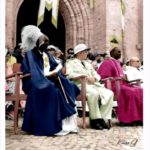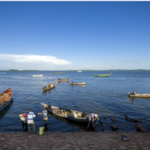The Nyabingi Cult
In the Northern peripheral areas we do not find the Ryangombe cult but the Nyabingi cult. Gravel mentions that the Nyabingi cult spread from the North to Gisaka in the East shortly after the advent of the Europeans (1 9 6 8p.147). The Nyabingi cult is however not restricted to Rwanda as it is also found in Kigezi, Uganda.
In Rwanda there are different versions as to the identity of Nyabingi. Summarising the different versions; Nyabingi was a daughter of the king of Ndorwa, belonging to a Tutsi lineage. She somehow managed to succeed her father to the kingship. But she is killed by a cousin who connived to do so with the co-operation of the king of Rwanda. After her death the Mwami of Rwanda forcibly occupied Ndorwa but nevermanaged to establish proper administrative control. Nyabingi, who was killed with all her servants, supposedly ‘never died but remained with her people, however she remained invisible.
Various points in the organization of the Nyabingi cult, which contrast with the Ryangombe cult, shows how it was able to, and in fact did, constitute a force opposing further annexation of the North by central Rwanda. The Nyabingicult had official priests and priestesses, who were believed to be able to intercede with Nyabingi in order to gain her protection. This protection could be given to anyone, protection only to those who had been initiated. However Nyabingi priests demanded substantial payment in goods for their services as intermediaries. Hence they were often extremely wealthy and had extensive powers. They further surrounded themselves with an armed retinue of servants for protection who could also be used in extorting any payment due to the priest.
The organization of the Nyabingi cult, which was widespread in the North, thus provided both the means for physical resistance of central government in the North and a religious rallying point against external threat to the area. Onseveral occasions it has been recorded that the Nyabingi cult was in fact used in revolts.
The central government also realised the potential threat of the Nyabingi organisation in the North. For instance, during the invasion of the North by Rwabugiri, several of the priestesses were put to death. Contrary to the Ryangombe cult in central Rwanda, the Nyabingi cult can be seen in some sense as a revolutionary both, inits myth of origin and in the uses to which its actualorganisation could be put. Pauwels gives several names of priests and priestesses who were in recent times either putto death or put in prison. (1957 P.255) Thus theorganisation of the cult provided a framework for expressingopposition to the encroachment of authority in the North. This anti-authoritarian tendency carried over into the colonial era.
When the colonial powers introduced Central Rwanda administration into the North, it became a centre of opposition against all the recently introduced forms of authority. The Fyabingi cult was officially forbidden in 1922 and the movement went underground. Phus the Nyabingi cult was an element of social cohesion in the North in as much as it was a force, expressed in religious terms, which opposed the newly established authority. It provided a focus for common identity in the face of the same authority through which Nyabingi had perished and which now did not allow expression of the cult rendered to Nyabingi. Whether the spread of the Nyabingi cult into Gisaka, after the arrival of the Europeans, mentioned by Gravel, is related to these aspects could only have been established by research at that time. To sum up this incomplete and summary survey of the religious complex in Rwanda, we may say that the cult ofthe dead was the most general and characteristic featureof religious practices. It had the function of upholding traditional patterns of behaviour and fostering good relations within and outside the lineage. The Ryangombe cult in Central Rwanda and the Nyabingi cult in the peripheral areas had definite sectional overtones and the Nyabingi cult had definite anti-central government tendencies.
https://uk.amateka.net/the-nyabingi-cult/https://uk.amateka.net/wp-content/uploads/2019/11/imigenzo.jpghttps://uk.amateka.net/wp-content/uploads/2019/11/imigenzo-150x150.jpgSocial & cultureIn the Northern peripheral areas we do not find the Ryangombe cult but the Nyabingi cult. Gravel mentions that the Nyabingi cult spread from the North to Gisaka in the East shortly after the advent of the Europeans (1 9 6 8p.147). The Nyabingi cult is however not restricted to Rwanda as it...BarataBarata rpierre@ikaze.netAdministratorAMATEKA | HISTORY OF RWANDA




